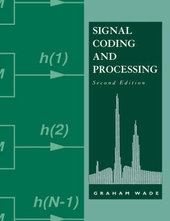
|
Signal Coding and Processing
Paperback / softback
Main Details
| Title |
Signal Coding and Processing
|
| Authors and Contributors |
By (author) Graham Wade
|
| Physical Properties |
| Format:Paperback / softback | | Pages:460 | | Dimensions(mm): Height 246,Width 189 |
|
| Category/Genre | Electrical engineering
Communications engineering and telecommunications |
|---|
| ISBN/Barcode |
9780521423366
|
| Classifications | Dewey:621.3822 |
|---|
| Audience | | Tertiary Education (US: College) | |
|---|
| Edition |
2nd Revised edition
|
| Illustrations |
Worked examples or Exercises; 31 Tables, unspecified; 1 Halftones, unspecified; 236 Line drawings, unspecified
|
|
Publishing Details |
| Publisher |
Cambridge University Press
|
| Imprint |
Cambridge University Press
|
| Publication Date |
8 September 1994 |
| Publication Country |
United Kingdom
|
Description
Signal coding and signal processing are complex and critical elements of communications systems in broadcasting, satellite, and magnetic recording fields among others. Because both signal coding and processing are often found within a single electronic system (especially large communications systems), this book uniquely combines an introduction to both of these areas and provides an uncluttered theoretical treatment of optical coding and processing algorithms, together with design information for practical systems. The author examines Pulse Code Modulation fundamentals, surveys modern data compression techniques, introduces block and convolutional error control codes, and discusses modern transmission coding techniques. Complete with problems and solutions, and containing over 230 diagrams, this textbook will be invaluable to third- and fourth-year undergraduates in electronic, electrical, or communication engineering. It will also act as a useful reference for anyone working in this technologically important field.
Reviews'Plenty of well-described examples and discusses practical realisations of many of the techniques covered. This book forms a useful reference text and would make a valuable addition to the technical library of anyone involved in signal coding or processing.' Inverse Problems Newsletter, Institute of Physics
|